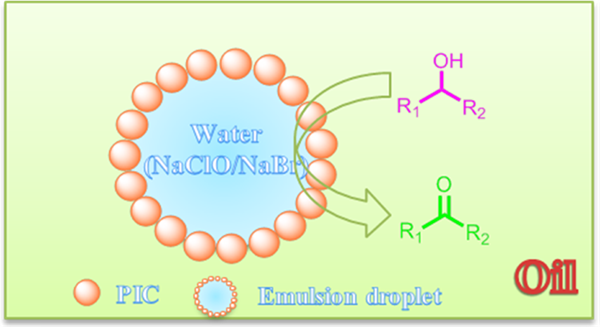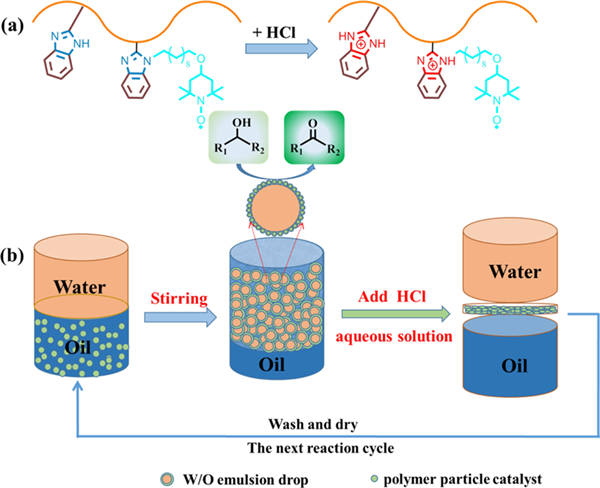TEMPO-Functionalized Aromatic Polymer as a Highly Active, pH Responsive Polymeric Interfacial Catalyst for Alcohol Oxidation
writer:Kecheng Hu, Jun Tang, Shixiong Cao, Qi Zhang, Jianli Wang*, and Zhibin Ye*
keywords:TEMPO, pH responsive polymeric interfacial catalyst, pickering emulsion
source:期刊
specific source:The Journal of Physical Chemistry C
Issue time:2019年

通過將2,2,6,6-四甲基哌啶-N-氧化物(TEMPO)一步接枝到具有苯并咪唑基團的聚芳醚酮(SCBI-PAEK-6F)上,設計合成了一種pH響應性聚合物界面催化劑(PIC)。并用1H核磁共振、傅里葉變換紅外光譜、元素分析、接觸角和透射電鏡對聚合物進行了系統的表征。這種精心設計的聚合物已經應用于Montanari條件下的醇的氧化。這種功能化聚合物可在水-油界面聚集并充當有效穩定劑以促進穩定的Pickering乳液形成,其通過微反應器機理對醇的氧化反應表現出優異的催化活性。此外,由于苯并咪唑基團的存在,PIC具有較好的pH響應性。我們通過簡單地將體系pH值調節至3,就可以實現Pickering乳液反應體系的去乳化,從而促進PIC回收。此外,可持續催化劑可以在隨后的醇氧化循環中重復使用,且催化活性或選擇性沒有明顯的損失。
We report in this paper the design and synthesis of a pH responsive polymeric interfacial catalyst (PIC) via one-step grafting of 2,2,6,6-tetramethylpiperidine-N-oxyl (TEMPO) onto a polyaryletherketone having pendant benzimidazole groups (SCBI-PAEK-6F). The TEMPO-functionalized polymer has been systematically characterized with 1H nuclear magnetic resonance, Fourier-transform infrared spectroscopy, elemental analysis, contact angle, and transmission electron microscopy. Moreover, this well-designed polymer has been applied in the oxidation of alcohols under Montanari conditions. It is found that the functionalized polymer can aggregate at the water-oil interface and act as an efficient stabilizer to facilitate the formation of a stable Pickering emulsion, which shows outstanding catalytic activity for alcohol oxidation through the microreactor mechanism. Moreover, the PIC is featured with desirable high pH responsiveness due to the valuable benzimidazole groups. De-emulsification of the Pickering emulsion reaction system can be conveniently triggered by simply tuning the system pH value to 3, thus facilitating the facile recovery of the PIC. In addition, the sustainable catalyst can be reused for subsequent cycles of alcohol oxidation without appreciable loss in catalytic activity or selectivity.

DOI: 10.1021/acs.jpcc.9b00467